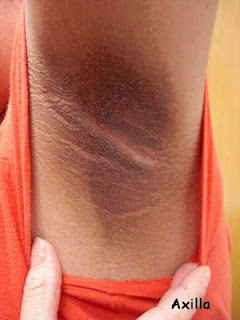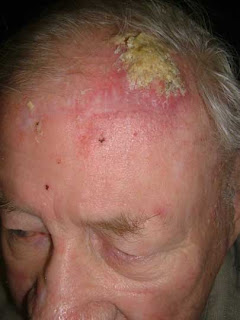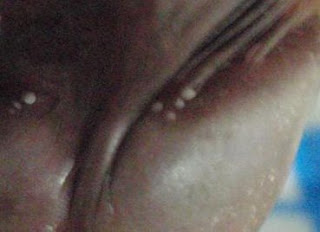Nov. 15, 2008 Dear Dr. Elpern, I was wondering if you had any idea what this skin rash / irritation is being caused by. On my hands and feet I've got these little red dots scattered all over. They don't itch, but offer a mild pain when applying pressure. Most of them are plush (sic) with the skin, but some of them are raised up slightly. Also my taste buds are inflamed and red... but I think this is an unrelated condition. Any help you could offer would be greatly appreciated.
He wrote back on December 20, 2008: Shortly after writing you the dots seemed to go away, so I didn't bother setting up an appointment; however, although the red dots went away, I did notice that the white half circle, that are supposed to be at the bottom of the nail, seemed to become weird and displaced on both middle fingers. About two weeks went by and nothing really changed. Yesterday things got worse. Both my middle finger nails seem to be falling off at their roots. I'm not sure what's causing this, and I was wondering if you thought I should set up an appointment, or if you think that I should seek help elsewhere.
O/E: The patient was seen on December 23, 2008: At this time, he had a separation of the proximal nail fold of both middle fingers. No other abnormal findings.
Clinical Photos:


Diagnosis: Post viral onychomadesis. The illness he had was most likely Hand, Foot and Mouth Disease or a related enterovirus infection. I have never seen nail dystrophy after this, but onychomadesis has been reported at least three times after similar episodes. One report is of an outbreak in Spain. I wonder if this is not another enterovirus infection.
Question: Has anyone else seen this?
References:
1. Salazar A, et al. Onychomadesis outbreak in Valencia, Spain, June 2008. Euro Surveill. 2008 Jul 3;13(27). pii: 18917. Available Full Text
2. Bernier V, Labrèze C, Bury F, Taïeb A. Nail matrix arrest in the course of hand, foot and mouth disease. Eur J Pediatr. 2001 Nov;160(11):649-51
Onychomadesis describes complete nail shedding from the proximal portion; it is consecutive to a nail matrix arrest and can affect both fingernails and toenails. It is a rare disorder in children. Except for serious generalised diseases or inherited forms, most cases are considered to be idiopathic. Few reports in literature concern common triggering phenomena. We present four patients in whom the same benign viral condition in childhood appeared as a stressful event preceding onychomadesis. In each case, spontaneous complete healing of the nails was achieved within a few weeks. CONCLUSION: Onychomadesis and/or onycholysis is a newly recognised complication in the course of viral infections presenting clinically as hand, foot and mouth disease, and because of mild forms, is probably underestimated.
Clementz GC, Mancini AJ. Nail matrix arrest following hand-foot-mouth disease: a report of five children. Pediatr Dermatol. 2000 Jan-Feb;17(1):7-11.
Hand-foot-mouth disease (HFMD) is a contagious enteroviral infection occurring primarily in children and characterized by a vesicular palmoplantar eruption and erosive stomatitis. Nail matrix arrest has been associated with a variety of drug exposures and systemic illnesses, including infections, and may result in a variety of changes, including transverse ridging (Beau's lines) and nail shedding (onychomadesis). The association of HFMD with Beau's lines and onychomadesis has not been reported previously. Five children, ages 22 months-4 years, presented with Beau's lines and/or onychomadesis following physician-diagnosed HFMD by 3-8 weeks. Three of the five patients experienced fever with HFMD, and none had a history of nail trauma, periungual dermatitis, periungual vesicular lesions, or a significant medication intake history. All patients experienced HFMD within 4 weeks of one another, and all resided in the suburbs of the Chicago metropolitan area. In all patients the nail changes were temporary with spontaneous normal regrowth. The mechanism of the nail matrix arrest is unclear, but the timing and geographic clustering of the patients suggests an epidemic caused by the same viral strain.
Comment: It is likely that this young man's nails will regrow. However, it may take longer than in a young child. All other previous cases have been in children. It is also possible that this is a related virus and not the usual putative agent of HFAM Disease.



























